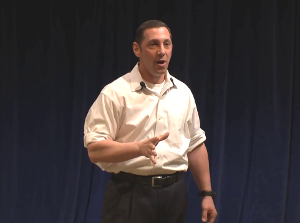
Have you ever watched a TED talk?
TED hasn't really made it to the mainstream yet, but if you ask most business consultants, thought leaders, speakers, educators, and (I would say) ALL millennials in college, they would be all too familiar with a TED talk.
In fact, it seems many organizations, including the National Speakers Association (NSA) and the Young Presidents' Organization (YPO), have adopted a TED-like format for their conferences and other related meetings.
According to their website, a TED talk is a video created from a presentation at the main TED (technology, entertainment, design) conference or one of its many satellite events around the world. TED talks are limited to a maximum length of 18 minutes but may be on any topic. TED looks for engaging, charismatic speakers whose talks expose new ideas that are supported by concrete evidence and are relevant to a broad, international audience.
 The first TED conference was in 1984 and the conference has been held annually since 1990. Over the years, presenters of TED talks have included Al Gore, Bill Clinton, Bill Gates, Bono, Jane Goodall, Malcolm Gladwell, Anthony Robbins and just recently, Monica Lewinsky.
The first TED conference was in 1984 and the conference has been held annually since 1990. Over the years, presenters of TED talks have included Al Gore, Bill Clinton, Bill Gates, Bono, Jane Goodall, Malcolm Gladwell, Anthony Robbins and just recently, Monica Lewinsky.
TEDx is the local, self-organized version of TED. I just attended a TEDx rehearsal where all the speakers (some were students, others academics) got a chance to do a practice run. As I observed their presentations, a few best practices came to mind that could help you generate more business.
Start with your best stuff!
Many TED talks begin with a direct statement. Social media is actually preventing many of us from establishing real life personal connections. We're losing sight of the value of the personal touch. Of course, your best stuff can be a direct statement, a story, statistic, a "Did you know...", or a quote. Try not to let your "best stuff" be, "Good morning, my name is...and I'm here to discuss..."
Tell stories to make your points
Audiences remember stories. Especially stories they can relate to and that create an emotional charge. The best stories are colorful and detailed, but not wordy. If you can tell a story in a succinct and yet compelling way, you'll be able to take your audience for a ride. Just make sure the last stop is a relevant point you're looking to make with them.
Organize your main thoughts
It's always best if your audience can follow your main points. "I have a few ideas about Long Term Care that I want to share with you." Or, "Here are the five most important things you need to know about Long Term Care. First, ..."
Relate to Your Audience
Your topic, stories, main points, sub points, and the overall purpose of your presentation (to inform, persuade, or entertain) needs to be about your audience - not you as the speaker. You can certainly tell stories about yourself and share experiences but try to put yourself in your audience's shoes. What is important to them? What problems are they looking to solve? How can you help them? What should they do about it?
Use Humor When Possible
Depending on your topic, main points, and context, humor can be a nice way to keep your audience engaged while making you likeable and relateable. Heck, you may surprise attendees who thought they were in for a boring presentation on life insurance.
Maintain Eye Contact
Always keep your eyes on your audience and give each section of the room equal time. When speaking, I view my audience in thirds - the left, right, and center. This way, I'm able to split my time in the form of my eye contact in three even ways. This is especially true when you're speaking from notes or PowerPoint. In fact, the less notes and information on slides you have, the less compelled you will be to peek at them.
End with a Call-to-Action
In TED talks, most speakers will offer a call to action or an invitation to consider something, think differently, or to take action to make a difference. What do you ultimately want from your audience? There's all different styles when it comes to "selling from the stage". I tend to take more of a soft sell approach. "If you like my ideas and want to learn more, let me know. If you think I can help you with...let's discuss and see what might make sense." If you're clever, you could start with your Call-to-Action at the beginning of your presentation (your best stuff?), then circle back and repeat in your close. Just make sure your presentation is full of great ideas and not simply an infomercial.
Why are these speaking points this important to you?
As a sales professional, broker, planner, or wholesaler (especially given all the speaking you do!), if you can take important information and incorporate these ideas in a brief presentation that matters, you'll be more impactful about making a connection with your audience and ultimately, writing more business.
Who's your target market? How can you get them in a room to listen to you speak about important information that can help them? When will you get started?
Sell your next seminar not your next appointment.
There's your Call-to-Action!